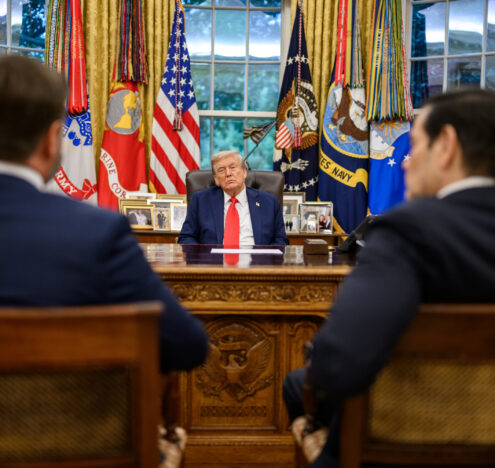When President Joe Biden took office with Democratic majorities in both chambers of Congress one year ago, proponents of nuclear arms control and more disciplined Pentagon spending expected that this year’s defense policy bill, the National Defense Authorization Act for the Fiscal Year 2022 (NDAA), would make real progress on issues that Biden has championed throughout his life.
Instead, the final product of the new Democratic majority rubber-stamped nearly every single existing nuclear weapons policy, to the tune of more than $43 billion for nuclear weapons programs, and in some cases increased costs to the taxpayers without having had a full debate in both chambers of Congress.
This is unacceptable.
There needs to be a robust debate in Congress about how to maintain and modernize our nuclear deterrent while eliminating waste and minimizing the chance that a nuclear weapon is ever used again. To do this, Congress would be well served by fighting for fiscal responsibility inside of the Pentagon, ending the push to create a new generation of more “usable” nuclear weapons, and exercising oversight that pushes for basic cost-saving measures and alternatives to the nuclear triad.
A BLANK CHECK FOR NUKES
One of the biggest news stories related to NDAA this cycle was how both Senate and House Republicans — with support from many Democrats — boosted the topline authorization level by $25.1 billion from the Biden administration’s initial request, which was more than the last Trump budget, already the highest Pentagon spending since the Vietnam war. When considering that the budget already is measured in trillions, this may not seem a large increase, but it does not force the Pentagon to be strategic in its budgeting and effectively gives a blank check to parts of the defense budget that require more scrutiny — not less.
Arguing against the increase on the House floor, Congresswoman Sara Jacobs (D-CA) put it best:
“We need to have an honest conversation about the Pentagon budget — and focus on what is achievable, what the real threats are, and what we actually need for our national security. For the last 20 years, we’ve been told we need more. But I think it’s time to recognize that there are simply not military solutions to every problem.”
Current nuclear weapons modernization plans, which are not set to peak for another decade, could total up to $2 trillion over the next 30 years. By the end of this decade, nuclear weapons could account for nearly 10% of the total national defense spending. How does that obscene amount of money keep Americans safe from the real threats they face today, including global pandemics or state-sponsored cybersecurity breaches? While much of this spending has already been committed, there are still many opportunities to save taxpayer dollars and avoid exacerbating a new arms race while strengthening the US deterrent.
By the end of this decade, nuclear weapons could account for nearly 10% of the total national defense spending. How does that obscene amount of money keep Americans safe from the real threats they face today, including global pandemics or cybersecurity breaches?
To do this, though, Congress will have to force the Pentagon to identify and prepare for the actual threats while lowering the overall level of defense spending. No topline pressure means the Pentagon will continue to request, and Congress will continue to authorize and appropriate wasteful funding that does not necessarily make Americans safer. Without congressional pressure, nuclear spending will be left unchecked and we will see more of what we did this year when Democrats couldn’t even agree to defund an obsolete and unnecessary nuclear weapon, the last megaton B83 gravity bomb, that was slated for retirement under the Obama administration.
A RETURN TO COLD WAR NUCLEAR WARFIGHTING DOCTRINES
This year’s NDAA authorized spending on a new nuclear sea-launched cruise missile (SLCM-N) to be tipped with a new low-yield warhead. It also includes language to prohibit retiring or reconverting the W76-2 low-yield nuclear warheads unless certain conditions are met. The Trump administration supported both capabilities in its 2018 Nuclear Posture Review which called for new “low-yield” or tactical nuclear warfighting capabilities to augment conventional forces. Not only is this logic dangerously flawed since the United States already maintains enough nuclear weapons to ensure its deterrence, but it disregards one of the greatest lessons from the Cold War: A nuclear war — even a “limited” one — cannot be won and must never be fought.
The SLCM-N was not slated for initial Research and Development funding until this fiscal year, so many believed it would be swiftly canceled by Biden, who called it a “bad idea” on the campaign trail. Democrats introduced bicameral legislation to halt the “costly and redundant Trump-era program” that would “hinder, not help, [the Navy’s] ability to deter aggressive actions by our adversaries.” However, despite Biden’s previous opposition, the White House included $15.2 million in its FY22 budget request for the program and Congress authorized full funding for the missile and its warhead with virtually no debate. (The House Appropriations Committee did block all funding for the program and the final appropriations bill is still being negotiated.)
By providing initial authorization for the SLCM-N and including language preemptively blocking retirement of the W76-2, Congress is effectively endorsing weapons designed to be “more usable,” an odd turn during an administration that supposedly wants to decrease the likelihood of a nuclear war.
CONCERN, BUT IN THE WRONG WAY
Labeled as “some of the most dangerous weapons in the world” by former Secretary of Defense Bill Perry, land-based ICBMs and the $264 billion plan to replace the existing fleet with a new missile and warhead remain controversial. Many have pushed for the Pentagon to pause the development of the new Ground Based Strategic Deterrent (GBSD) and extend the life of the existing missiles for an interim period at a lower cost instead while further study is given to the continuation of this leg of the nuclear triad.
As this public conversation on the GBSD program has increased, congressional interest has followed. For the past three years, House Democrats have offered some version of an amendment in committee or on the floor to call for an independent review of the program, and, in two instances, cut funding. These efforts have all been rejected so far, though a majority of House Democrats did vote for this year’s amendment.
Conversely, the provisions that did make it into this year’s final NDAA signal congressional resistance to considering changes to or a discontinuation of the ICBM program. For example, the bill bars reducing the number of deployed ICBMs below their current level of 400, requires an annual certification of whether the readiness of the Minuteman III ICBMs necessitates placing nuclear-armed heavy bombers on alert, and asks for a cost estimate if such a re-alerting were to be necessary. It also demands documents related to a small contract awarded to a think tank to study future options for the ICBM program, conveying disapproval of the Pentagon’s decision to fund the study.
The backlash to those even just questioning the GBSD program showcases the outdated thinking that still drives nuclear policy throughout the halls of Congress, fueled by the power of the ICBM lobby. It also illustrates the fear of GBSD-proponents of the conclusions of any potentially money-saving options. Unfortunately, they are succeeding in their campaign and passing provisions into law that will serve as future obstacles to demonstrate that replacing the current missiles on a one-to-one basis with the GBSD is the wish of Congress, even if the Biden administration forces the Pentagon to review alternatives.
LOOKING TO THE NUCLEAR POSTURE REVIEW AND FUTURE BUDGETS
Democrats can find easy excuses for allowing this wasteful bill to pass: The administration’s budget request was delivered extremely late this year, leading to rushed progress. Biden showed no leadership by failing to cut any Trump nuclear weapons programs in the request. Razor-thin Democratic majorities in both chambers required the bill to be bipartisan. And, of course, the most prevalent and the easiest: Our adversaries, especially Russia and China, are modernizing their deterrents and increasing the threat to the United States.
All these statements are true.
None of them, however, justify writing a blank check for every new nuclear weapons system that paranoid imagination can conjure. They do not require us to bring back dangerous Cold War warfighting thinking, nor to fund an extremely expensive and controversial new ICBM program with little congressional or independent oversight.
Every year, Democratic leadership says that next year will be the year they can get something done to set a new course on progressive national security priorities. The truth is that if they had this much trouble passing what is essentially a Republican bill, there is likely little hope of getting any real fiscal responsibility into next year’s NDAA, especially given the upcoming November midterms.
Congress could benefit from strong leadership and strategic guidance from the White House in its forthcoming Nuclear Posture Review in order to start trimming nuclear excess. But it should not wait around for leadership from an already spread-thin White House before it decides to act. Instead, the current congressional majority should provide a bold vision for national security that makes America safer, not only from adversaries but from its own fiscal imprudence.
Now is the time for strategic leadership to make smart and purposeful cuts to maintain a deterrent based on modern needs, not antiquated wants.
Monica Montgomery is the Advocacy Coordinator for the Council for a Livable World, where her work focuses on building congressional champions for nuclear arms control and nonproliferation, reducing the Pentagon budget, and working on electing members of Congress who share these goals.




















